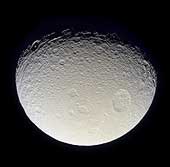|
COMETS EARTH JUPITER KUIPER BELT MARS MERCURY METEORITES NEPTUNE OORT CLOUD PLUTO SATURN SOLAR SYSTEM SPACE SUN URANUS VENUS ORDER PRINTS
PHOTO CATEGORIES SCIENCEVIEWS AMERICAN INDIAN AMPHIBIANS BIRDS BUGS FINE ART FOSSILS THE ISLANDS HISTORICAL PHOTOS MAMMALS OTHER PARKS PLANTS RELIGIOUS REPTILES SCIENCEVIEWS PRINTS
|
Related Documents
Download Options
Having now passed closer to Tethys than the Voyager 2 spacecraft, Cassini has returned the best-ever natural color view of this icy Saturnian moon. As seen here, the battered surface of Tethys (1,060 kilometers, or 659 miles across) has a neutral hue. The image here is a mosaic of two footprints. Three images taken in the red, green and blue filters were taken to form a natural color composite. The result reveals a world nearly saturated with craters - many small craters lie on top of older, larger ones, suggesting an ancient surface. At the top and along the boundary between day and night, the moon's terrain has a grooved appearance. This moon is known to have a density very close to that of water, indicating it is likely composed mainly of water ice. Its frozen mysteries await Cassini's planned close flyby in September 2005. The view shows primarily the trailing hemisphere of Tethys, which is the side opposite the moon's direction of motion in its orbit. The image has been rotated so that north on Tethys is up. The images comprising this color view were taken with the Cassini spacecraft narrow angle camera on Oct. 28, 2004, at a distance of about 256,000 kilometers (159,000 miles) from Tethys and at a Sun-Tethys-spacecraft, or phase, angle of 50 degrees. The image scale is 1.5 kilometers (0.9 miles) per pixel. |
